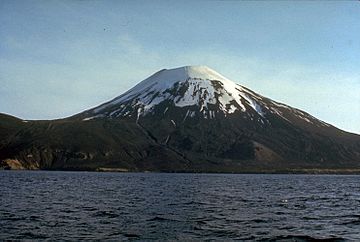Mount Amukta facts for kids
Quick facts for kids Mount Amukta |
|
|---|---|

Mt. Amukta, June 1972
|
|
| Highest point | |
| Elevation | 3,497 ft (1,066 m) |
| Geography | |
| Location | Amukta Island, Alaska, U.S. |
| Parent range | Aleutian Range |
| Topo map | USGS Amukta C-4 |
| Geology | |
| Mountain type | Stratovolcano |
| Volcanic arc/belt | Aleutian Arc |
| Last eruption | March 1997 |
Amukta volcano is a tall, cone-shaped mountain on Amukta Island in Alaska. It is known as a stratovolcano, which means it's built up over time by layers of lava and ash from many eruptions. The island itself is almost perfectly round, about 7.7 kilometers (4.8 miles) wide.
Amukta Island is part of the Islands of Four Mountains chain. It's the most western island in this group. The volcano has a crater at its top, which is about 0.4 kilometers (0.25 miles) wide. Scientists believe the volcano sits on top of an older, much larger volcanic crater called a caldera. This older caldera is about 6 kilometers (3.7 miles) wide and opens up to the sea on the south side of the island.
Contents
Volcanic Eruptions and Activity
Amukta volcano has erupted several times throughout history. It's important to keep track of these events to understand how the volcano behaves.
Early Reported Eruptions
People first noted activity at Amukta between 1786 and 1791. Another eruption was recorded in 1876. Some old records also mention activity around 1770, though details are a bit unclear.
The 1963 Eruption
On February 13, 1963, Amukta had a significant eruption. Ash and lava came out from the main crater and other smaller openings on the volcano's sides. Thick clouds made it hard to see exactly where the lava came from. However, people saw the lava flow down the west side of the volcano and into the sea at a place called Traders Cove.
Activity in the 1980s and 1990s
In late August and early September 1987, a pilot saw a huge plume of ash rising about 10.5 kilometers (6.5 miles) high from the volcano. A few days later, another pilot saw a smaller ash plume coming from the top of Amukta. On September 18, yet another pilot reported a 300-meter (980-foot) high ash plume.
In early July 1996, a ship passing by reported a 1-kilometer (0.6-mile) high plume of "ash and smoke." Around the same time, Mt. Cleveland, another volcano about 100 kilometers (62 miles) away, was also active. Winds were blowing towards Amukta, which can sometimes make it tricky to tell which volcano is erupting.
What is Amukta Made Of?
The rocks found around Amukta volcano are mostly basalt. Basalt is a common type of volcanic rock that forms from cooled lava. Other types of rocks, like granite and monzonite, can also be found, but basalt is the most common.
Images for kids


